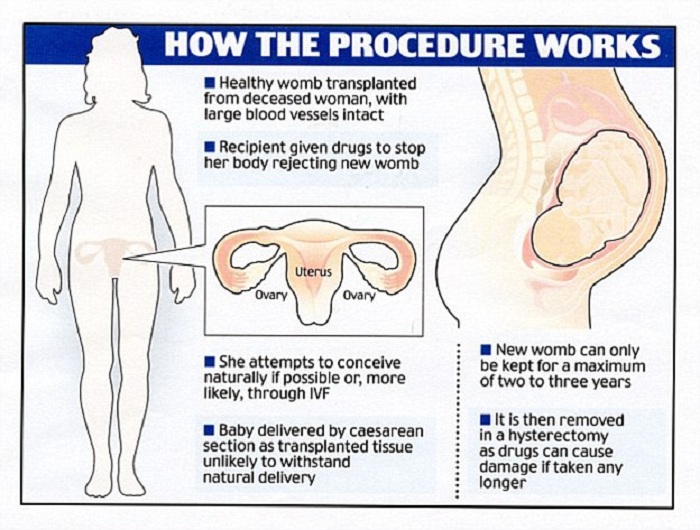It was an attempt to replicate the only successful transplants in the world, which took place in Sweden in 2014. Five of the nine Swedish patients went on to have healthy babies.
Despite having to remove three of the wombs due to restricted blood flow, lead surgeon Dr Giuliano Testa told TIME this marks a milestone in America`s attempt to help infertile women give birth to their own child.
The new approach comes seven months after America`s first ever uterus transplant in Ohio`s Cleveland Clinic failed. The transplant, which came from a deceased donor, was removed days later due to a yeast infection.

`If you look at this from the science [perspective], it`s something we`ve learned a lot from, and we have a patient who is doing well,` Dr Testa told TIME.
`This is the beginning of hopefully a great history for medicine.`
By the end of 2016, Dr Testa and his team plan to perform six more transplants.
He added: `This is the way we advance, from learning from our mistakes.
`I am not ashamed of being the one who will be remembered as the guy who did four [transplants] in the beginning and three failed.
`Even if through failure, I am going to make this work. I believe from an ethical and clinical and research point of view, we have our heart in the right place.`
All of the women in the Dallas trial have a condition called Mayer-Rokitansky-Küster-Hauser (MRKH) syndrome, which affects the reproductive system. Some were also born without a womb.
The Dallas transplants, like that in Cleveland, are aimed at women with what`s called uterine factor infertility, meaning they were born without a uterus or with uterine abnormalities that block pregnancy.
If a woman is approved for a transplant, she would first have to have eggs removed from her ovaries, like is done for in vitro fertilization, and then freeze the embryos.
Those could be implanted only 12 months after the transplant heals, if it`s successful.
The womb and blood vessels are sewn inside the recipient`s pelvis.
Before closing the abdomen, surgeons check for good blood flow and that the attachment to the ligaments is strong enough to maintain a pregnancy.
The first attempt in Cleveland used a deceased donor. This would have come from a woman left brain-dead by a car crash, heart defect, brain hemorrhage or another illness.
Aged 18 to 50, they would have been kept alive on a ventilator until their womb were removed in a three-hour operation.
This time, however, the donations came from live donors.
The recipients were aged between 20 and 35. The donors were aged between 35 and 60.
According to TIME, these donors were all so-called `altruistic donors`, meaning they are not related to the recipients and do not know who they are.
Dr Testa said 50 women offered to donate.
`They told us, "we had our chance to become mothers, and now we have this uterus and it`s not doing anything for us. We can put this uterus to use for people who really need it." That struck me as a physician. These women are phenomenal,` Dr Testa said.
The first attempt at a uterus transplant was performed in Saudi Arabia in 2000, and failed due to blood clotting. The uterus was removed after three months.
In 2011, there was a second attempt in Turkey.
Though the recipient managed to conceive, her pregnancy was terminated at eight weeks when doctors couldn`t detect a heart beat, and the operation was also deemed a failure.
To ensure the new uterus is healthy enough for a pregnancy, recipients must wait a year before doctors perform in vitro fertilization.
Once a woman has had one or two children and the donor womb is no longer needed, it is removed by a team of surgeons.
This would prevent the need for the woman to be on immune-suppressing drugs for the rest of her life.
















































